Management Accounting Report for Merlin Financial Consultants Analysis
VerifiedAdded on 2020/10/05
|19
|5663
|433
Report
AI Summary
This comprehensive report delves into the realm of management accounting, using Merlin Financial Consultants as a case study. It meticulously examines the core principles of management accounting, contrasting it with financial accounting, and explores the essential requirements of various management accounting systems, including cost accounting, inventory management, job costing, and price optimization. The report details different management accounting reporting methods, emphasizing information relevancy and the types of reports such as budget reports, credit control reports, and job cost reports. A key focus is on cost analysis techniques, with a detailed comparison between absorption costing and marginal costing, illustrated through income statement examples. Furthermore, the report analyzes the advantages of different planning tools and their application within a management accounting framework and concludes by addressing how organizations use management accounting to respond to financial problems, ultimately leading to sustainable success. The report provides a well-structured analysis of management accounting principles and their practical application.
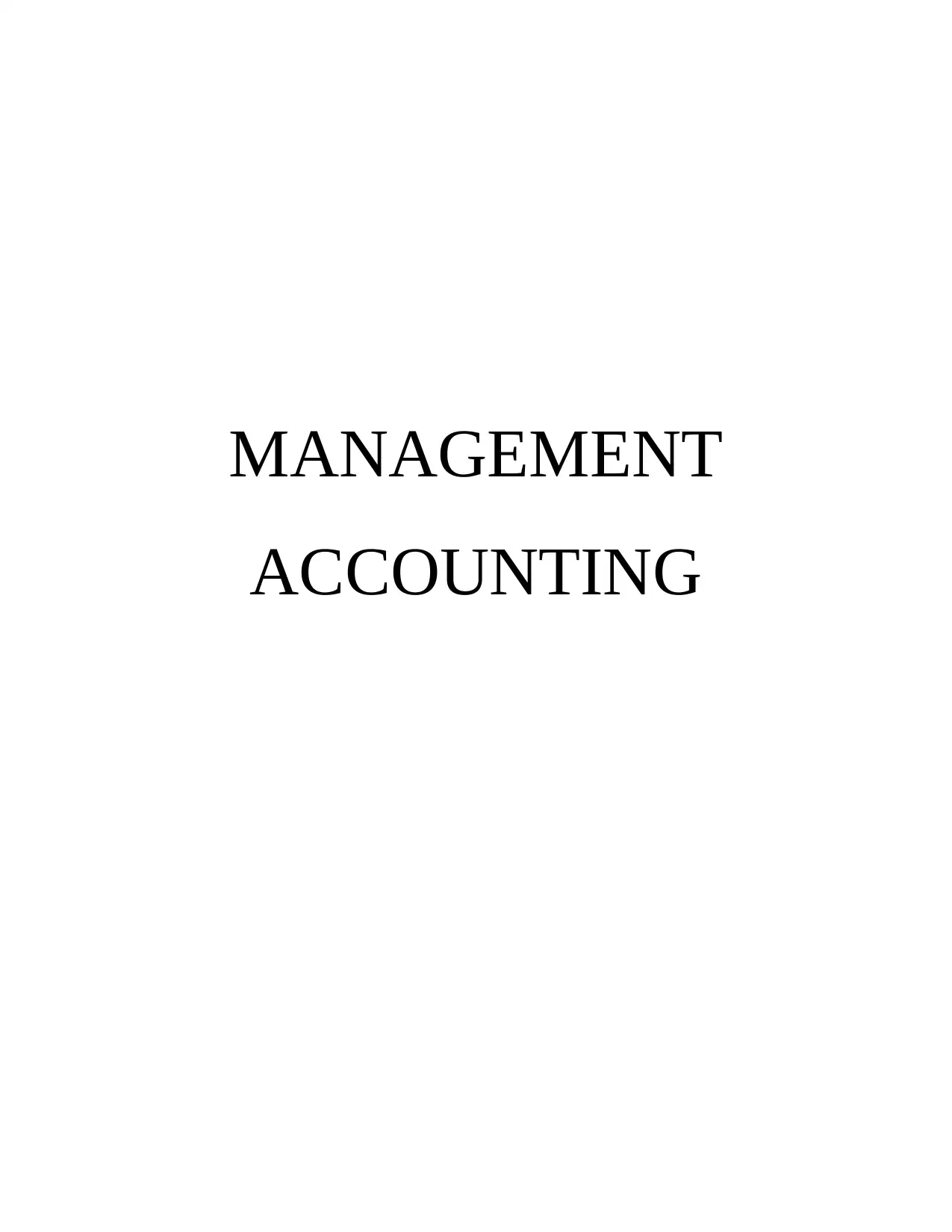
MANAGEMENT
ACCOUNTING
ACCOUNTING
Paraphrase This Document
Need a fresh take? Get an instant paraphrase of this document with our AI Paraphraser
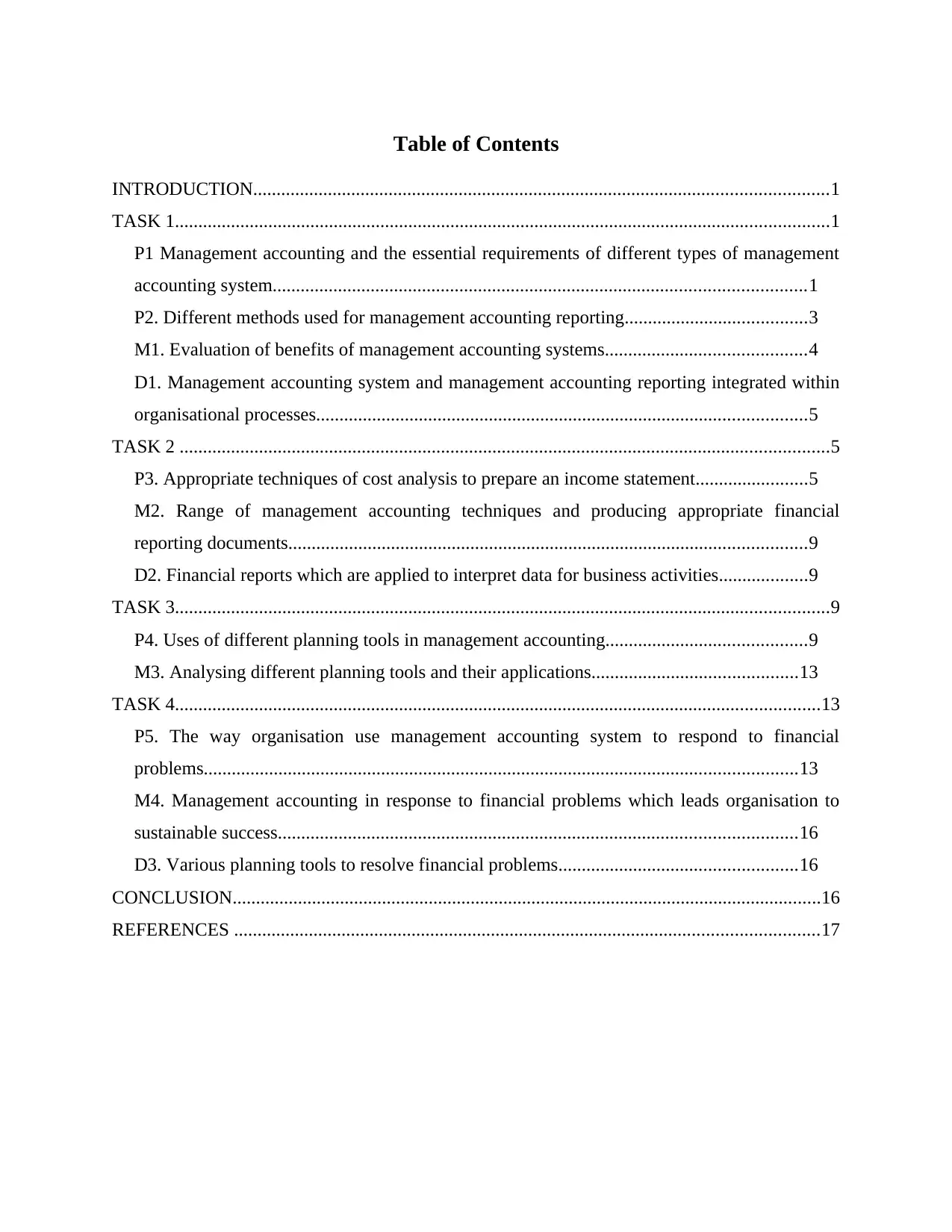
Table of Contents
INTRODUCTION...........................................................................................................................1
TASK 1............................................................................................................................................1
P1 Management accounting and the essential requirements of different types of management
accounting system..................................................................................................................1
P2. Different methods used for management accounting reporting.......................................3
M1. Evaluation of benefits of management accounting systems...........................................4
D1. Management accounting system and management accounting reporting integrated within
organisational processes.........................................................................................................5
TASK 2 ...........................................................................................................................................5
P3. Appropriate techniques of cost analysis to prepare an income statement........................5
M2. Range of management accounting techniques and producing appropriate financial
reporting documents...............................................................................................................9
D2. Financial reports which are applied to interpret data for business activities...................9
TASK 3............................................................................................................................................9
P4. Uses of different planning tools in management accounting...........................................9
M3. Analysing different planning tools and their applications............................................13
TASK 4..........................................................................................................................................13
P5. The way organisation use management accounting system to respond to financial
problems...............................................................................................................................13
M4. Management accounting in response to financial problems which leads organisation to
sustainable success...............................................................................................................16
D3. Various planning tools to resolve financial problems...................................................16
CONCLUSION..............................................................................................................................16
REFERENCES .............................................................................................................................17
INTRODUCTION...........................................................................................................................1
TASK 1............................................................................................................................................1
P1 Management accounting and the essential requirements of different types of management
accounting system..................................................................................................................1
P2. Different methods used for management accounting reporting.......................................3
M1. Evaluation of benefits of management accounting systems...........................................4
D1. Management accounting system and management accounting reporting integrated within
organisational processes.........................................................................................................5
TASK 2 ...........................................................................................................................................5
P3. Appropriate techniques of cost analysis to prepare an income statement........................5
M2. Range of management accounting techniques and producing appropriate financial
reporting documents...............................................................................................................9
D2. Financial reports which are applied to interpret data for business activities...................9
TASK 3............................................................................................................................................9
P4. Uses of different planning tools in management accounting...........................................9
M3. Analysing different planning tools and their applications............................................13
TASK 4..........................................................................................................................................13
P5. The way organisation use management accounting system to respond to financial
problems...............................................................................................................................13
M4. Management accounting in response to financial problems which leads organisation to
sustainable success...............................................................................................................16
D3. Various planning tools to resolve financial problems...................................................16
CONCLUSION..............................................................................................................................16
REFERENCES .............................................................................................................................17
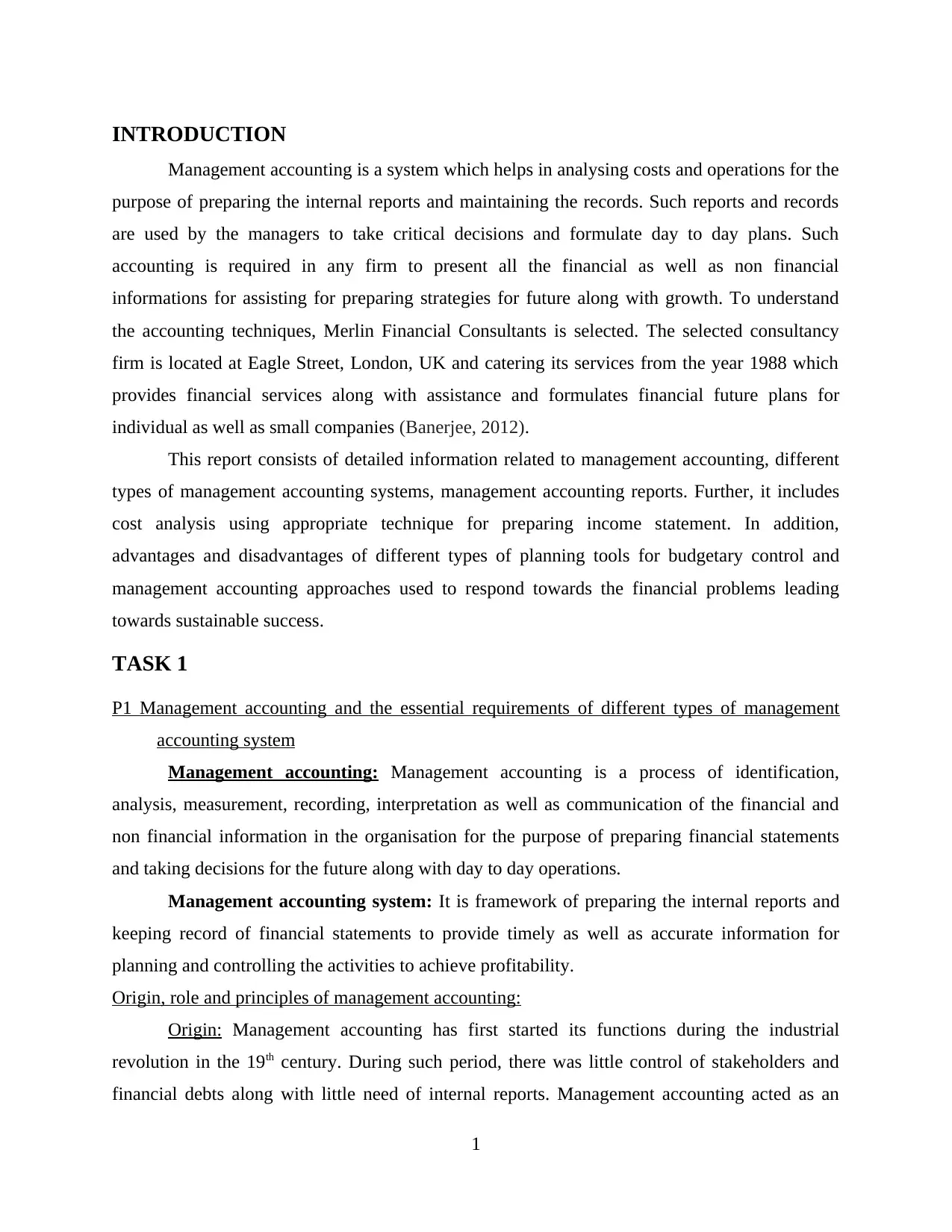
INTRODUCTION
Management accounting is a system which helps in analysing costs and operations for the
purpose of preparing the internal reports and maintaining the records. Such reports and records
are used by the managers to take critical decisions and formulate day to day plans. Such
accounting is required in any firm to present all the financial as well as non financial
informations for assisting for preparing strategies for future along with growth. To understand
the accounting techniques, Merlin Financial Consultants is selected. The selected consultancy
firm is located at Eagle Street, London, UK and catering its services from the year 1988 which
provides financial services along with assistance and formulates financial future plans for
individual as well as small companies (Banerjee, 2012).
This report consists of detailed information related to management accounting, different
types of management accounting systems, management accounting reports. Further, it includes
cost analysis using appropriate technique for preparing income statement. In addition,
advantages and disadvantages of different types of planning tools for budgetary control and
management accounting approaches used to respond towards the financial problems leading
towards sustainable success.
TASK 1
P1 Management accounting and the essential requirements of different types of management
accounting system
Management accounting: Management accounting is a process of identification,
analysis, measurement, recording, interpretation as well as communication of the financial and
non financial information in the organisation for the purpose of preparing financial statements
and taking decisions for the future along with day to day operations.
Management accounting system: It is framework of preparing the internal reports and
keeping record of financial statements to provide timely as well as accurate information for
planning and controlling the activities to achieve profitability.
Origin, role and principles of management accounting:
Origin: Management accounting has first started its functions during the industrial
revolution in the 19th century. During such period, there was little control of stakeholders and
financial debts along with little need of internal reports. Management accounting acted as an
1
Management accounting is a system which helps in analysing costs and operations for the
purpose of preparing the internal reports and maintaining the records. Such reports and records
are used by the managers to take critical decisions and formulate day to day plans. Such
accounting is required in any firm to present all the financial as well as non financial
informations for assisting for preparing strategies for future along with growth. To understand
the accounting techniques, Merlin Financial Consultants is selected. The selected consultancy
firm is located at Eagle Street, London, UK and catering its services from the year 1988 which
provides financial services along with assistance and formulates financial future plans for
individual as well as small companies (Banerjee, 2012).
This report consists of detailed information related to management accounting, different
types of management accounting systems, management accounting reports. Further, it includes
cost analysis using appropriate technique for preparing income statement. In addition,
advantages and disadvantages of different types of planning tools for budgetary control and
management accounting approaches used to respond towards the financial problems leading
towards sustainable success.
TASK 1
P1 Management accounting and the essential requirements of different types of management
accounting system
Management accounting: Management accounting is a process of identification,
analysis, measurement, recording, interpretation as well as communication of the financial and
non financial information in the organisation for the purpose of preparing financial statements
and taking decisions for the future along with day to day operations.
Management accounting system: It is framework of preparing the internal reports and
keeping record of financial statements to provide timely as well as accurate information for
planning and controlling the activities to achieve profitability.
Origin, role and principles of management accounting:
Origin: Management accounting has first started its functions during the industrial
revolution in the 19th century. During such period, there was little control of stakeholders and
financial debts along with little need of internal reports. Management accounting acted as an
1
⊘ This is a preview!⊘
Do you want full access?
Subscribe today to unlock all pages.

Trusted by 1+ million students worldwide
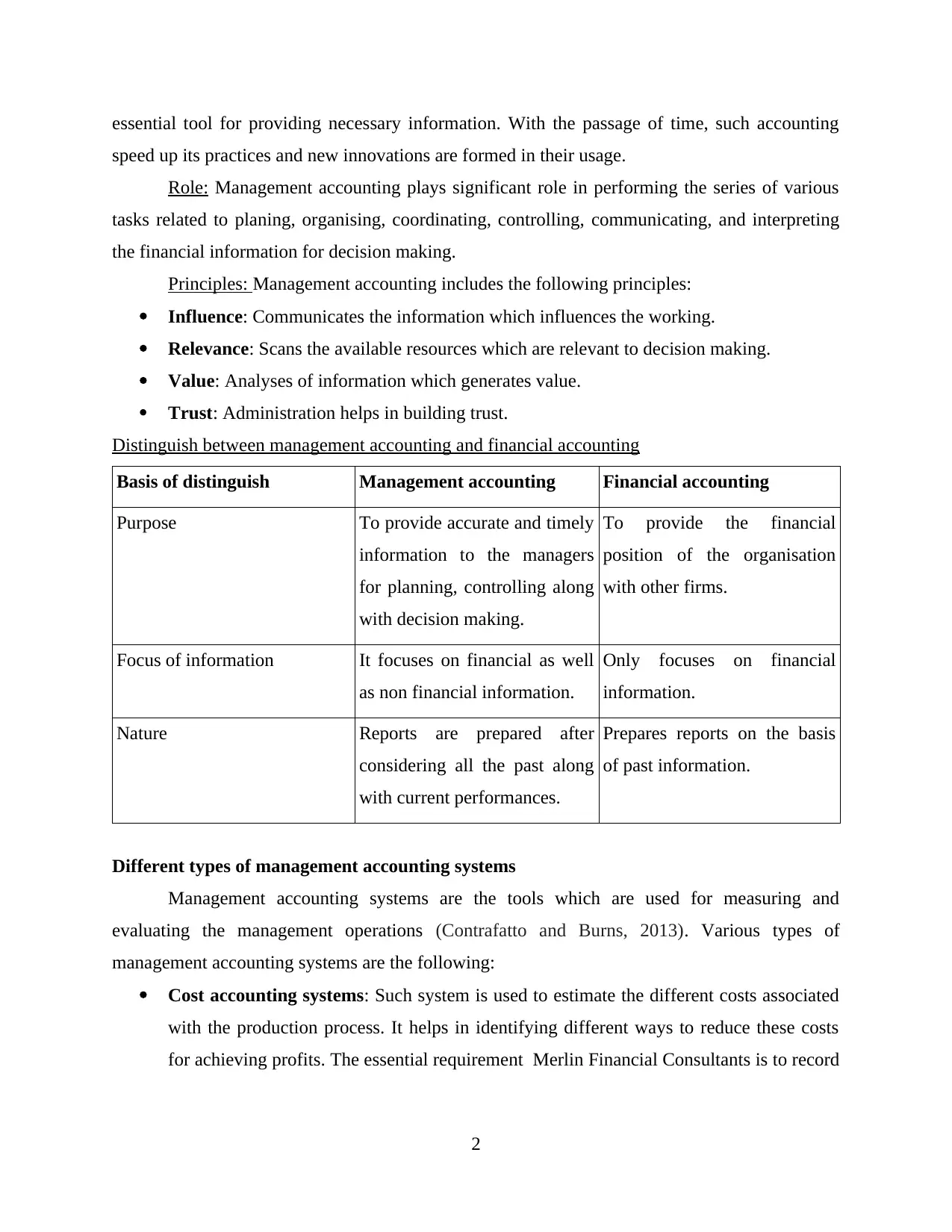
essential tool for providing necessary information. With the passage of time, such accounting
speed up its practices and new innovations are formed in their usage.
Role: Management accounting plays significant role in performing the series of various
tasks related to planing, organising, coordinating, controlling, communicating, and interpreting
the financial information for decision making.
Principles: Management accounting includes the following principles:
Influence: Communicates the information which influences the working.
Relevance: Scans the available resources which are relevant to decision making.
Value: Analyses of information which generates value.
Trust: Administration helps in building trust.
Distinguish between management accounting and financial accounting
Basis of distinguish Management accounting Financial accounting
Purpose To provide accurate and timely
information to the managers
for planning, controlling along
with decision making.
To provide the financial
position of the organisation
with other firms.
Focus of information It focuses on financial as well
as non financial information.
Only focuses on financial
information.
Nature Reports are prepared after
considering all the past along
with current performances.
Prepares reports on the basis
of past information.
Different types of management accounting systems
Management accounting systems are the tools which are used for measuring and
evaluating the management operations (Contrafatto and Burns, 2013). Various types of
management accounting systems are the following:
Cost accounting systems: Such system is used to estimate the different costs associated
with the production process. It helps in identifying different ways to reduce these costs
for achieving profits. The essential requirement Merlin Financial Consultants is to record
2
speed up its practices and new innovations are formed in their usage.
Role: Management accounting plays significant role in performing the series of various
tasks related to planing, organising, coordinating, controlling, communicating, and interpreting
the financial information for decision making.
Principles: Management accounting includes the following principles:
Influence: Communicates the information which influences the working.
Relevance: Scans the available resources which are relevant to decision making.
Value: Analyses of information which generates value.
Trust: Administration helps in building trust.
Distinguish between management accounting and financial accounting
Basis of distinguish Management accounting Financial accounting
Purpose To provide accurate and timely
information to the managers
for planning, controlling along
with decision making.
To provide the financial
position of the organisation
with other firms.
Focus of information It focuses on financial as well
as non financial information.
Only focuses on financial
information.
Nature Reports are prepared after
considering all the past along
with current performances.
Prepares reports on the basis
of past information.
Different types of management accounting systems
Management accounting systems are the tools which are used for measuring and
evaluating the management operations (Contrafatto and Burns, 2013). Various types of
management accounting systems are the following:
Cost accounting systems: Such system is used to estimate the different costs associated
with the production process. It helps in identifying different ways to reduce these costs
for achieving profits. The essential requirement Merlin Financial Consultants is to record
2
Paraphrase This Document
Need a fresh take? Get an instant paraphrase of this document with our AI Paraphraser
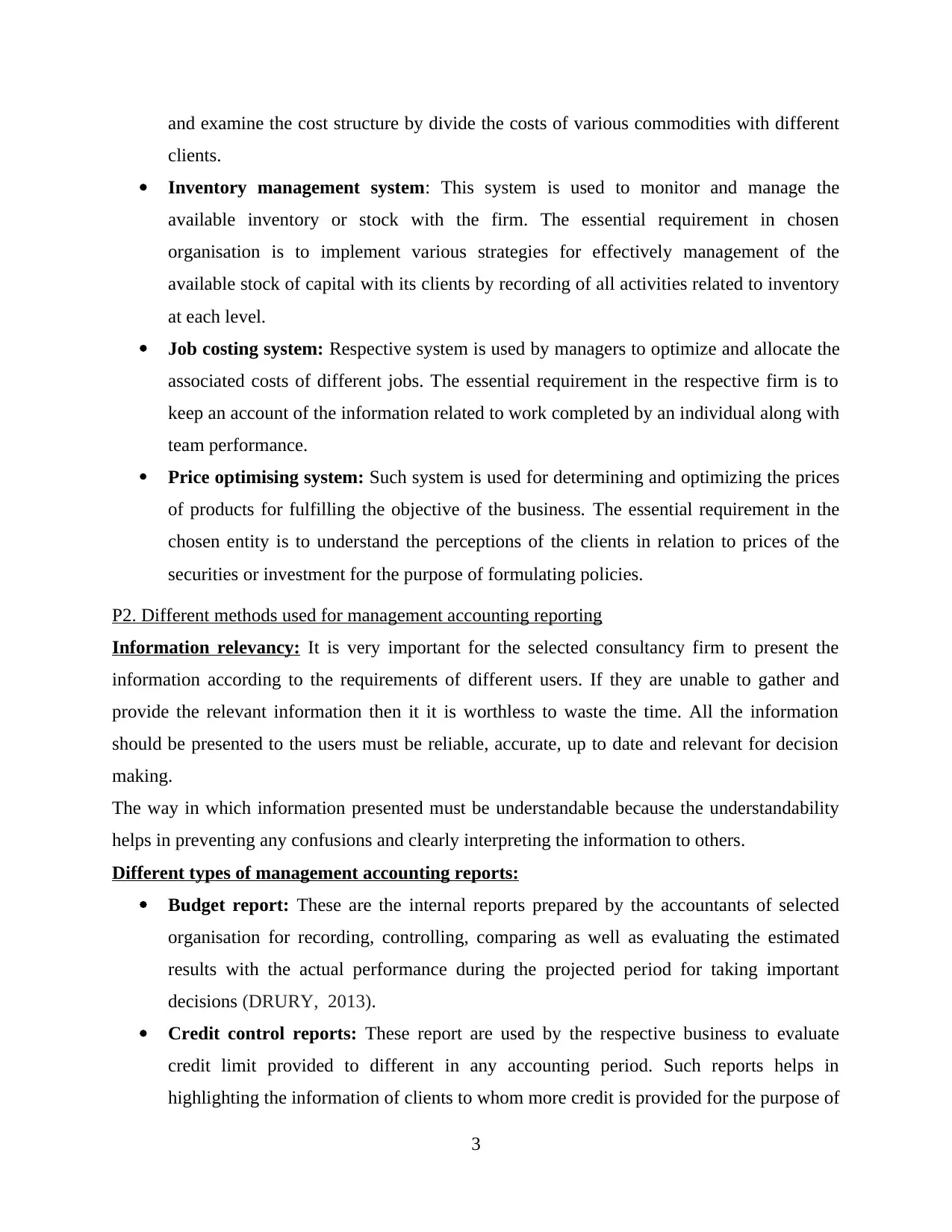
and examine the cost structure by divide the costs of various commodities with different
clients.
Inventory management system: This system is used to monitor and manage the
available inventory or stock with the firm. The essential requirement in chosen
organisation is to implement various strategies for effectively management of the
available stock of capital with its clients by recording of all activities related to inventory
at each level.
Job costing system: Respective system is used by managers to optimize and allocate the
associated costs of different jobs. The essential requirement in the respective firm is to
keep an account of the information related to work completed by an individual along with
team performance.
Price optimising system: Such system is used for determining and optimizing the prices
of products for fulfilling the objective of the business. The essential requirement in the
chosen entity is to understand the perceptions of the clients in relation to prices of the
securities or investment for the purpose of formulating policies.
P2. Different methods used for management accounting reporting
Information relevancy: It is very important for the selected consultancy firm to present the
information according to the requirements of different users. If they are unable to gather and
provide the relevant information then it it is worthless to waste the time. All the information
should be presented to the users must be reliable, accurate, up to date and relevant for decision
making.
The way in which information presented must be understandable because the understandability
helps in preventing any confusions and clearly interpreting the information to others.
Different types of management accounting reports:
Budget report: These are the internal reports prepared by the accountants of selected
organisation for recording, controlling, comparing as well as evaluating the estimated
results with the actual performance during the projected period for taking important
decisions (DRURY, 2013).
Credit control reports: These report are used by the respective business to evaluate
credit limit provided to different in any accounting period. Such reports helps in
highlighting the information of clients to whom more credit is provided for the purpose of
3
clients.
Inventory management system: This system is used to monitor and manage the
available inventory or stock with the firm. The essential requirement in chosen
organisation is to implement various strategies for effectively management of the
available stock of capital with its clients by recording of all activities related to inventory
at each level.
Job costing system: Respective system is used by managers to optimize and allocate the
associated costs of different jobs. The essential requirement in the respective firm is to
keep an account of the information related to work completed by an individual along with
team performance.
Price optimising system: Such system is used for determining and optimizing the prices
of products for fulfilling the objective of the business. The essential requirement in the
chosen entity is to understand the perceptions of the clients in relation to prices of the
securities or investment for the purpose of formulating policies.
P2. Different methods used for management accounting reporting
Information relevancy: It is very important for the selected consultancy firm to present the
information according to the requirements of different users. If they are unable to gather and
provide the relevant information then it it is worthless to waste the time. All the information
should be presented to the users must be reliable, accurate, up to date and relevant for decision
making.
The way in which information presented must be understandable because the understandability
helps in preventing any confusions and clearly interpreting the information to others.
Different types of management accounting reports:
Budget report: These are the internal reports prepared by the accountants of selected
organisation for recording, controlling, comparing as well as evaluating the estimated
results with the actual performance during the projected period for taking important
decisions (DRURY, 2013).
Credit control reports: These report are used by the respective business to evaluate
credit limit provided to different in any accounting period. Such reports helps in
highlighting the information of clients to whom more credit is provided for the purpose of
3
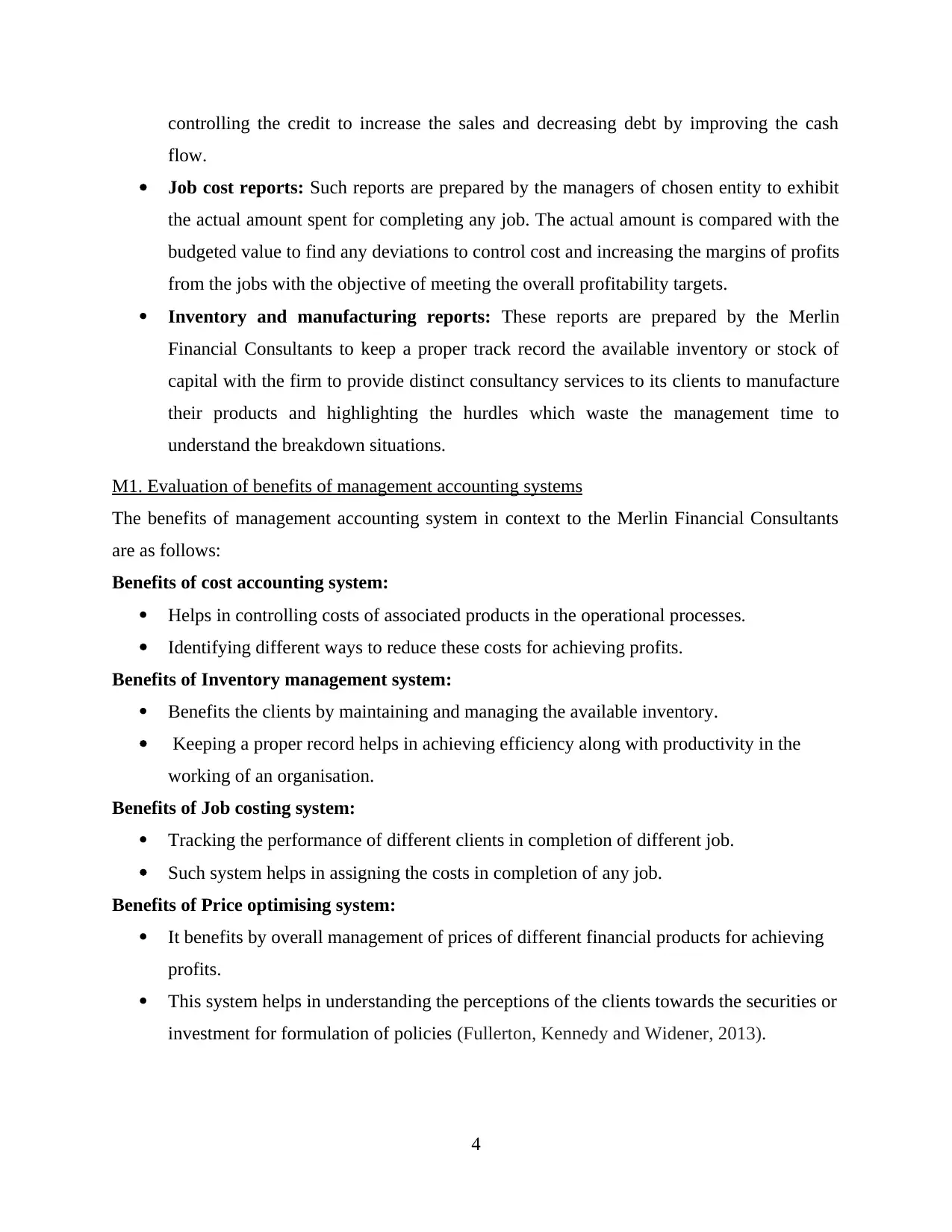
controlling the credit to increase the sales and decreasing debt by improving the cash
flow.
Job cost reports: Such reports are prepared by the managers of chosen entity to exhibit
the actual amount spent for completing any job. The actual amount is compared with the
budgeted value to find any deviations to control cost and increasing the margins of profits
from the jobs with the objective of meeting the overall profitability targets.
Inventory and manufacturing reports: These reports are prepared by the Merlin
Financial Consultants to keep a proper track record the available inventory or stock of
capital with the firm to provide distinct consultancy services to its clients to manufacture
their products and highlighting the hurdles which waste the management time to
understand the breakdown situations.
M1. Evaluation of benefits of management accounting systems
The benefits of management accounting system in context to the Merlin Financial Consultants
are as follows:
Benefits of cost accounting system:
Helps in controlling costs of associated products in the operational processes.
Identifying different ways to reduce these costs for achieving profits.
Benefits of Inventory management system:
Benefits the clients by maintaining and managing the available inventory.
Keeping a proper record helps in achieving efficiency along with productivity in the
working of an organisation.
Benefits of Job costing system:
Tracking the performance of different clients in completion of different job.
Such system helps in assigning the costs in completion of any job.
Benefits of Price optimising system:
It benefits by overall management of prices of different financial products for achieving
profits.
This system helps in understanding the perceptions of the clients towards the securities or
investment for formulation of policies (Fullerton, Kennedy and Widener, 2013).
4
flow.
Job cost reports: Such reports are prepared by the managers of chosen entity to exhibit
the actual amount spent for completing any job. The actual amount is compared with the
budgeted value to find any deviations to control cost and increasing the margins of profits
from the jobs with the objective of meeting the overall profitability targets.
Inventory and manufacturing reports: These reports are prepared by the Merlin
Financial Consultants to keep a proper track record the available inventory or stock of
capital with the firm to provide distinct consultancy services to its clients to manufacture
their products and highlighting the hurdles which waste the management time to
understand the breakdown situations.
M1. Evaluation of benefits of management accounting systems
The benefits of management accounting system in context to the Merlin Financial Consultants
are as follows:
Benefits of cost accounting system:
Helps in controlling costs of associated products in the operational processes.
Identifying different ways to reduce these costs for achieving profits.
Benefits of Inventory management system:
Benefits the clients by maintaining and managing the available inventory.
Keeping a proper record helps in achieving efficiency along with productivity in the
working of an organisation.
Benefits of Job costing system:
Tracking the performance of different clients in completion of different job.
Such system helps in assigning the costs in completion of any job.
Benefits of Price optimising system:
It benefits by overall management of prices of different financial products for achieving
profits.
This system helps in understanding the perceptions of the clients towards the securities or
investment for formulation of policies (Fullerton, Kennedy and Widener, 2013).
4
⊘ This is a preview!⊘
Do you want full access?
Subscribe today to unlock all pages.

Trusted by 1+ million students worldwide
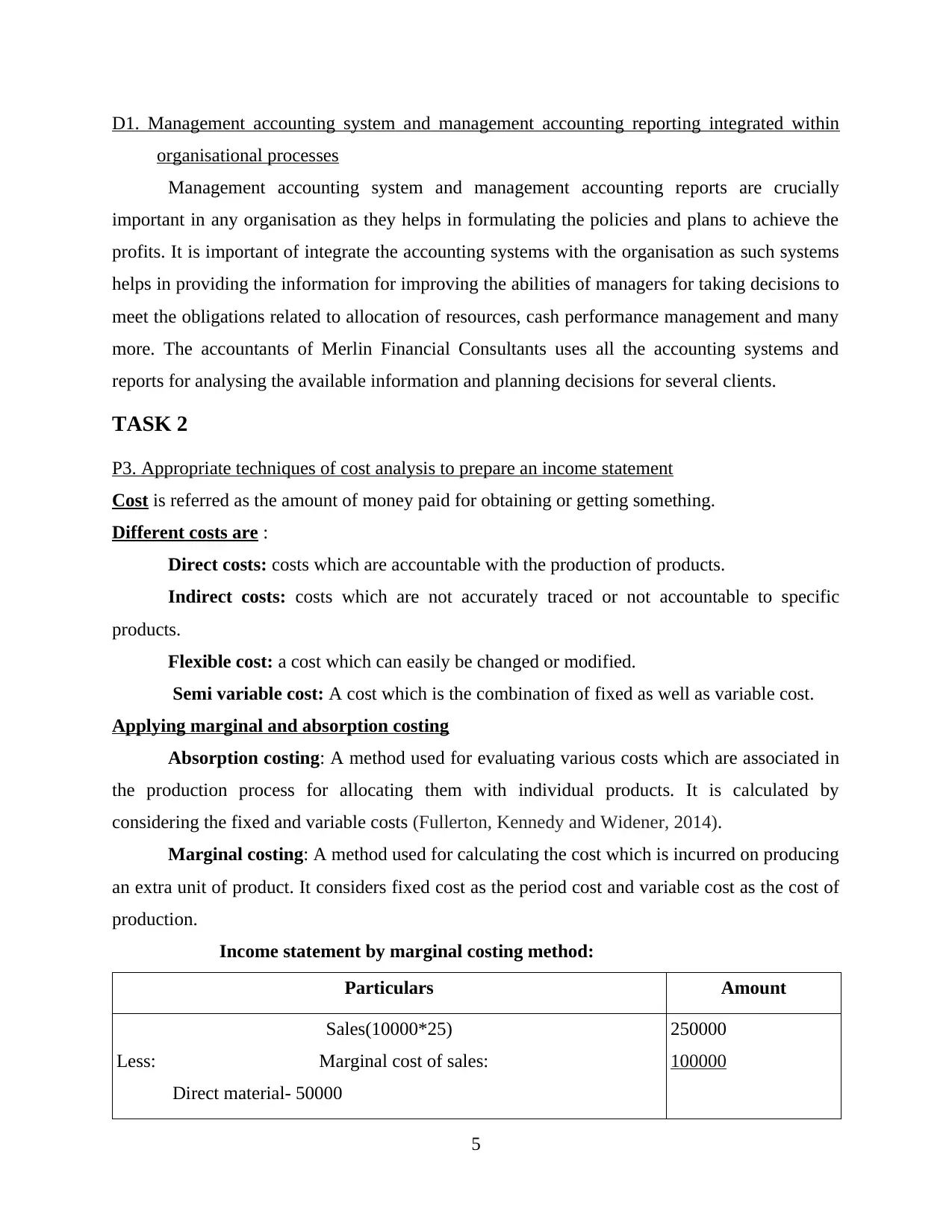
D1. Management accounting system and management accounting reporting integrated within
organisational processes
Management accounting system and management accounting reports are crucially
important in any organisation as they helps in formulating the policies and plans to achieve the
profits. It is important of integrate the accounting systems with the organisation as such systems
helps in providing the information for improving the abilities of managers for taking decisions to
meet the obligations related to allocation of resources, cash performance management and many
more. The accountants of Merlin Financial Consultants uses all the accounting systems and
reports for analysing the available information and planning decisions for several clients.
TASK 2
P3. Appropriate techniques of cost analysis to prepare an income statement
Cost is referred as the amount of money paid for obtaining or getting something.
Different costs are :
Direct costs: costs which are accountable with the production of products.
Indirect costs: costs which are not accurately traced or not accountable to specific
products.
Flexible cost: a cost which can easily be changed or modified.
Semi variable cost: A cost which is the combination of fixed as well as variable cost.
Applying marginal and absorption costing
Absorption costing: A method used for evaluating various costs which are associated in
the production process for allocating them with individual products. It is calculated by
considering the fixed and variable costs (Fullerton, Kennedy and Widener, 2014).
Marginal costing: A method used for calculating the cost which is incurred on producing
an extra unit of product. It considers fixed cost as the period cost and variable cost as the cost of
production.
Income statement by marginal costing method:
Particulars Amount
Sales(10000*25)
Less: Marginal cost of sales:
Direct material- 50000
250000
100000
5
organisational processes
Management accounting system and management accounting reports are crucially
important in any organisation as they helps in formulating the policies and plans to achieve the
profits. It is important of integrate the accounting systems with the organisation as such systems
helps in providing the information for improving the abilities of managers for taking decisions to
meet the obligations related to allocation of resources, cash performance management and many
more. The accountants of Merlin Financial Consultants uses all the accounting systems and
reports for analysing the available information and planning decisions for several clients.
TASK 2
P3. Appropriate techniques of cost analysis to prepare an income statement
Cost is referred as the amount of money paid for obtaining or getting something.
Different costs are :
Direct costs: costs which are accountable with the production of products.
Indirect costs: costs which are not accurately traced or not accountable to specific
products.
Flexible cost: a cost which can easily be changed or modified.
Semi variable cost: A cost which is the combination of fixed as well as variable cost.
Applying marginal and absorption costing
Absorption costing: A method used for evaluating various costs which are associated in
the production process for allocating them with individual products. It is calculated by
considering the fixed and variable costs (Fullerton, Kennedy and Widener, 2014).
Marginal costing: A method used for calculating the cost which is incurred on producing
an extra unit of product. It considers fixed cost as the period cost and variable cost as the cost of
production.
Income statement by marginal costing method:
Particulars Amount
Sales(10000*25)
Less: Marginal cost of sales:
Direct material- 50000
250000
100000
5
Paraphrase This Document
Need a fresh take? Get an instant paraphrase of this document with our AI Paraphraser
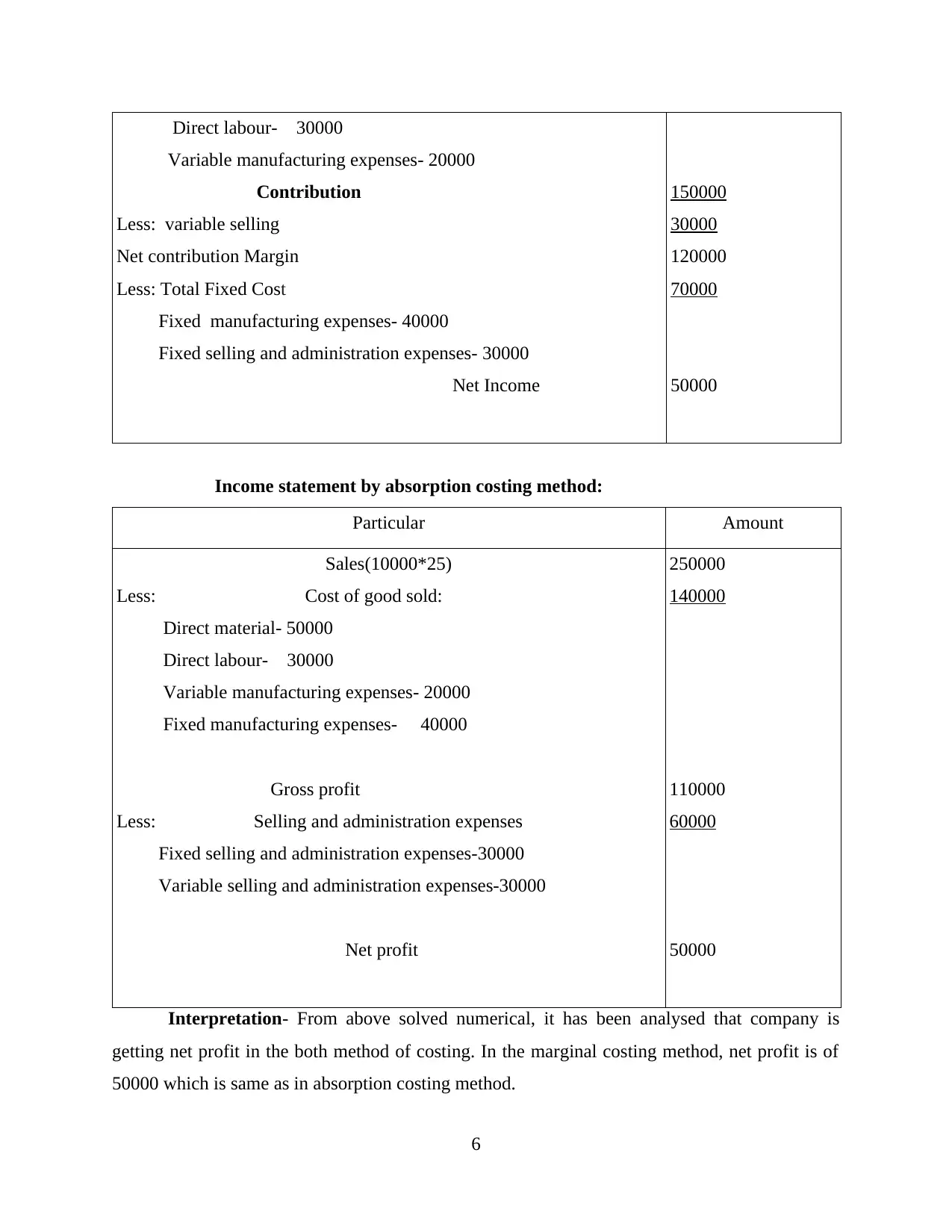
Direct labour- 30000
Variable manufacturing expenses- 20000
Contribution
Less: variable selling
Net contribution Margin
Less: Total Fixed Cost
Fixed manufacturing expenses- 40000
Fixed selling and administration expenses- 30000
Net Income
150000
30000
120000
70000
50000
Income statement by absorption costing method:
Particular Amount
Sales(10000*25)
Less: Cost of good sold:
Direct material- 50000
Direct labour- 30000
Variable manufacturing expenses- 20000
Fixed manufacturing expenses- 40000
Gross profit
Less: Selling and administration expenses
Fixed selling and administration expenses-30000
Variable selling and administration expenses-30000
Net profit
250000
140000
110000
60000
50000
Interpretation- From above solved numerical, it has been analysed that company is
getting net profit in the both method of costing. In the marginal costing method, net profit is of
50000 which is same as in absorption costing method.
6
Variable manufacturing expenses- 20000
Contribution
Less: variable selling
Net contribution Margin
Less: Total Fixed Cost
Fixed manufacturing expenses- 40000
Fixed selling and administration expenses- 30000
Net Income
150000
30000
120000
70000
50000
Income statement by absorption costing method:
Particular Amount
Sales(10000*25)
Less: Cost of good sold:
Direct material- 50000
Direct labour- 30000
Variable manufacturing expenses- 20000
Fixed manufacturing expenses- 40000
Gross profit
Less: Selling and administration expenses
Fixed selling and administration expenses-30000
Variable selling and administration expenses-30000
Net profit
250000
140000
110000
60000
50000
Interpretation- From above solved numerical, it has been analysed that company is
getting net profit in the both method of costing. In the marginal costing method, net profit is of
50000 which is same as in absorption costing method.
6
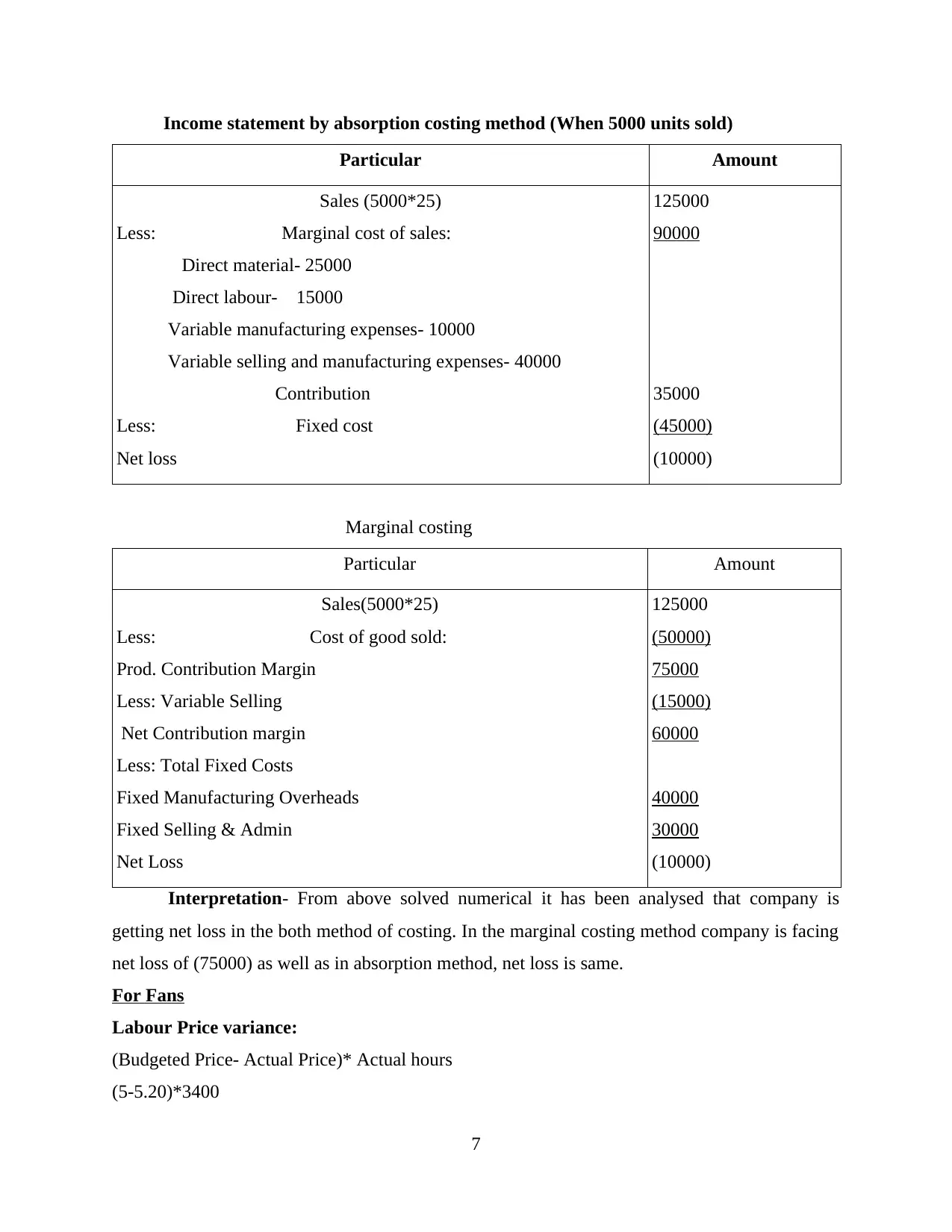
Income statement by absorption costing method (When 5000 units sold)
Particular Amount
Sales (5000*25)
Less: Marginal cost of sales:
Direct material- 25000
Direct labour- 15000
Variable manufacturing expenses- 10000
Variable selling and manufacturing expenses- 40000
Contribution
Less: Fixed cost
Net loss
125000
90000
35000
(45000)
(10000)
Marginal costing
Particular Amount
Sales(5000*25)
Less: Cost of good sold:
Prod. Contribution Margin
Less: Variable Selling
Net Contribution margin
Less: Total Fixed Costs
Fixed Manufacturing Overheads
Fixed Selling & Admin
Net Loss
125000
(50000)
75000
(15000)
60000
40000
30000
(10000)
Interpretation- From above solved numerical it has been analysed that company is
getting net loss in the both method of costing. In the marginal costing method company is facing
net loss of (75000) as well as in absorption method, net loss is same.
For Fans
Labour Price variance:
(Budgeted Price- Actual Price)* Actual hours
(5-5.20)*3400
7
Particular Amount
Sales (5000*25)
Less: Marginal cost of sales:
Direct material- 25000
Direct labour- 15000
Variable manufacturing expenses- 10000
Variable selling and manufacturing expenses- 40000
Contribution
Less: Fixed cost
Net loss
125000
90000
35000
(45000)
(10000)
Marginal costing
Particular Amount
Sales(5000*25)
Less: Cost of good sold:
Prod. Contribution Margin
Less: Variable Selling
Net Contribution margin
Less: Total Fixed Costs
Fixed Manufacturing Overheads
Fixed Selling & Admin
Net Loss
125000
(50000)
75000
(15000)
60000
40000
30000
(10000)
Interpretation- From above solved numerical it has been analysed that company is
getting net loss in the both method of costing. In the marginal costing method company is facing
net loss of (75000) as well as in absorption method, net loss is same.
For Fans
Labour Price variance:
(Budgeted Price- Actual Price)* Actual hours
(5-5.20)*3400
7
⊘ This is a preview!⊘
Do you want full access?
Subscribe today to unlock all pages.

Trusted by 1+ million students worldwide
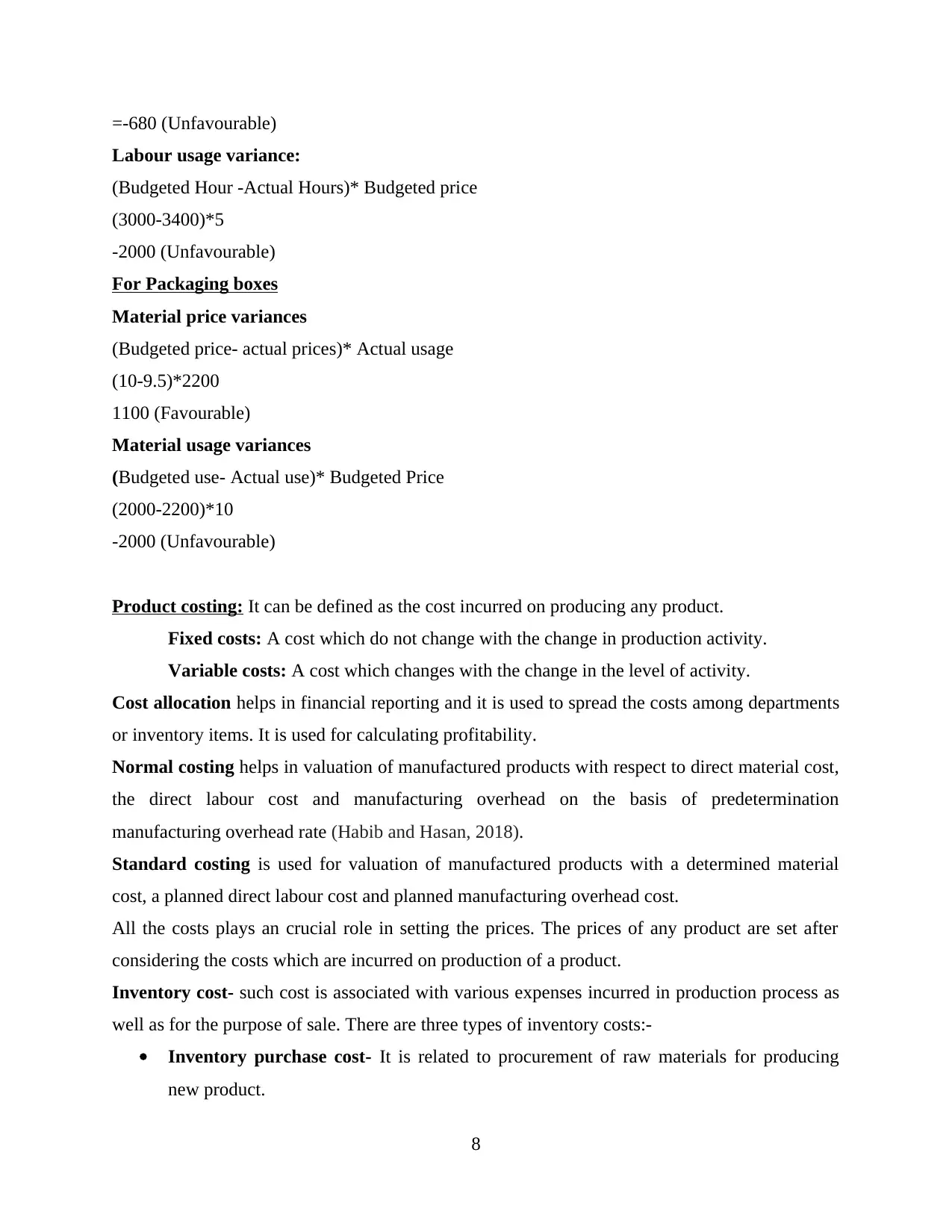
=-680 (Unfavourable)
Labour usage variance:
(Budgeted Hour -Actual Hours)* Budgeted price
(3000-3400)*5
-2000 (Unfavourable)
For Packaging boxes
Material price variances
(Budgeted price- actual prices)* Actual usage
(10-9.5)*2200
1100 (Favourable)
Material usage variances
(Budgeted use- Actual use)* Budgeted Price
(2000-2200)*10
-2000 (Unfavourable)
Product costing: It can be defined as the cost incurred on producing any product.
Fixed costs: A cost which do not change with the change in production activity.
Variable costs: A cost which changes with the change in the level of activity.
Cost allocation helps in financial reporting and it is used to spread the costs among departments
or inventory items. It is used for calculating profitability.
Normal costing helps in valuation of manufactured products with respect to direct material cost,
the direct labour cost and manufacturing overhead on the basis of predetermination
manufacturing overhead rate (Habib and Hasan, 2018).
Standard costing is used for valuation of manufactured products with a determined material
cost, a planned direct labour cost and planned manufacturing overhead cost.
All the costs plays an crucial role in setting the prices. The prices of any product are set after
considering the costs which are incurred on production of a product.
Inventory cost- such cost is associated with various expenses incurred in production process as
well as for the purpose of sale. There are three types of inventory costs:-
Inventory purchase cost- It is related to procurement of raw materials for producing
new product.
8
Labour usage variance:
(Budgeted Hour -Actual Hours)* Budgeted price
(3000-3400)*5
-2000 (Unfavourable)
For Packaging boxes
Material price variances
(Budgeted price- actual prices)* Actual usage
(10-9.5)*2200
1100 (Favourable)
Material usage variances
(Budgeted use- Actual use)* Budgeted Price
(2000-2200)*10
-2000 (Unfavourable)
Product costing: It can be defined as the cost incurred on producing any product.
Fixed costs: A cost which do not change with the change in production activity.
Variable costs: A cost which changes with the change in the level of activity.
Cost allocation helps in financial reporting and it is used to spread the costs among departments
or inventory items. It is used for calculating profitability.
Normal costing helps in valuation of manufactured products with respect to direct material cost,
the direct labour cost and manufacturing overhead on the basis of predetermination
manufacturing overhead rate (Habib and Hasan, 2018).
Standard costing is used for valuation of manufactured products with a determined material
cost, a planned direct labour cost and planned manufacturing overhead cost.
All the costs plays an crucial role in setting the prices. The prices of any product are set after
considering the costs which are incurred on production of a product.
Inventory cost- such cost is associated with various expenses incurred in production process as
well as for the purpose of sale. There are three types of inventory costs:-
Inventory purchase cost- It is related to procurement of raw materials for producing
new product.
8
Paraphrase This Document
Need a fresh take? Get an instant paraphrase of this document with our AI Paraphraser
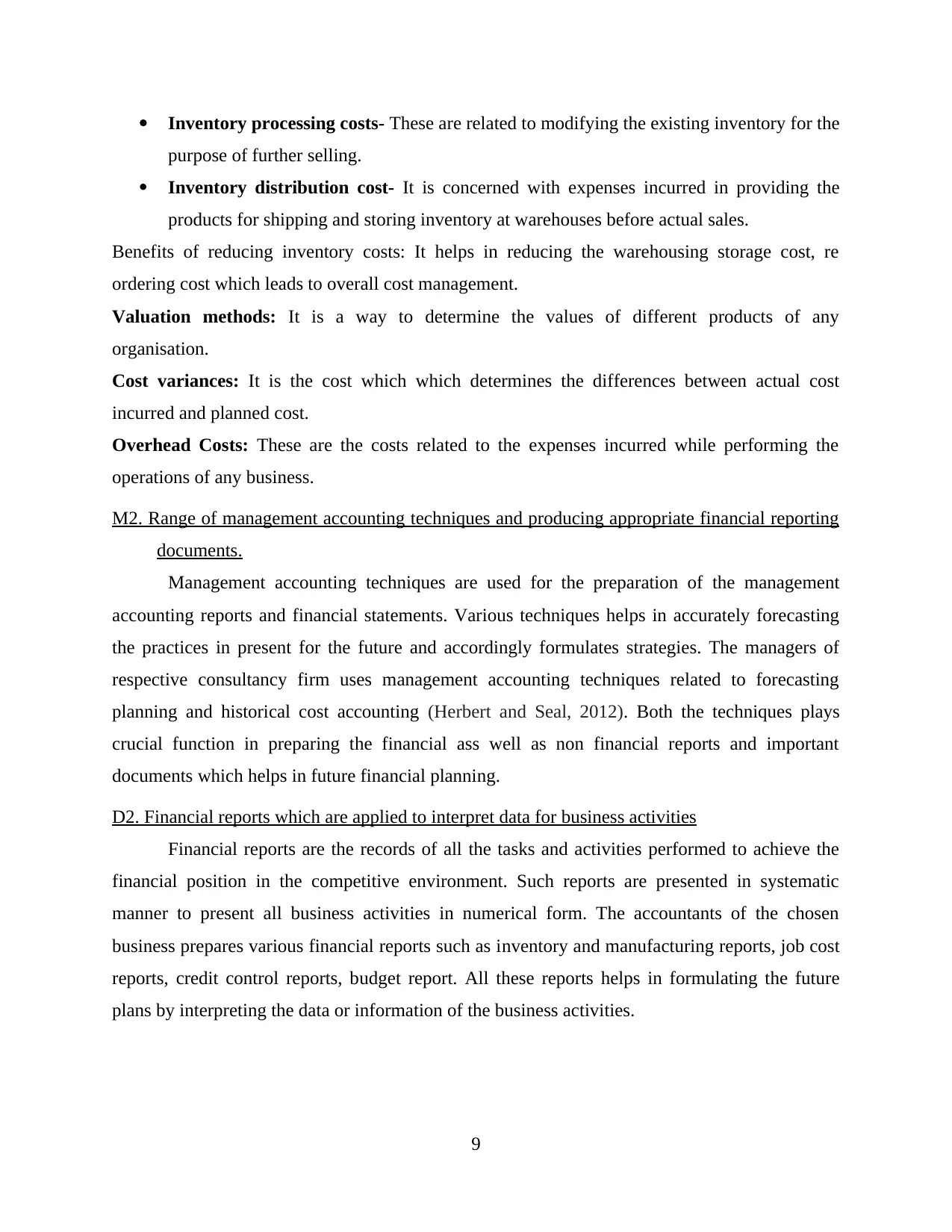
Inventory processing costs- These are related to modifying the existing inventory for the
purpose of further selling.
Inventory distribution cost- It is concerned with expenses incurred in providing the
products for shipping and storing inventory at warehouses before actual sales.
Benefits of reducing inventory costs: It helps in reducing the warehousing storage cost, re
ordering cost which leads to overall cost management.
Valuation methods: It is a way to determine the values of different products of any
organisation.
Cost variances: It is the cost which which determines the differences between actual cost
incurred and planned cost.
Overhead Costs: These are the costs related to the expenses incurred while performing the
operations of any business.
M2. Range of management accounting techniques and producing appropriate financial reporting
documents.
Management accounting techniques are used for the preparation of the management
accounting reports and financial statements. Various techniques helps in accurately forecasting
the practices in present for the future and accordingly formulates strategies. The managers of
respective consultancy firm uses management accounting techniques related to forecasting
planning and historical cost accounting (Herbert and Seal, 2012). Both the techniques plays
crucial function in preparing the financial ass well as non financial reports and important
documents which helps in future financial planning.
D2. Financial reports which are applied to interpret data for business activities
Financial reports are the records of all the tasks and activities performed to achieve the
financial position in the competitive environment. Such reports are presented in systematic
manner to present all business activities in numerical form. The accountants of the chosen
business prepares various financial reports such as inventory and manufacturing reports, job cost
reports, credit control reports, budget report. All these reports helps in formulating the future
plans by interpreting the data or information of the business activities.
9
purpose of further selling.
Inventory distribution cost- It is concerned with expenses incurred in providing the
products for shipping and storing inventory at warehouses before actual sales.
Benefits of reducing inventory costs: It helps in reducing the warehousing storage cost, re
ordering cost which leads to overall cost management.
Valuation methods: It is a way to determine the values of different products of any
organisation.
Cost variances: It is the cost which which determines the differences between actual cost
incurred and planned cost.
Overhead Costs: These are the costs related to the expenses incurred while performing the
operations of any business.
M2. Range of management accounting techniques and producing appropriate financial reporting
documents.
Management accounting techniques are used for the preparation of the management
accounting reports and financial statements. Various techniques helps in accurately forecasting
the practices in present for the future and accordingly formulates strategies. The managers of
respective consultancy firm uses management accounting techniques related to forecasting
planning and historical cost accounting (Herbert and Seal, 2012). Both the techniques plays
crucial function in preparing the financial ass well as non financial reports and important
documents which helps in future financial planning.
D2. Financial reports which are applied to interpret data for business activities
Financial reports are the records of all the tasks and activities performed to achieve the
financial position in the competitive environment. Such reports are presented in systematic
manner to present all business activities in numerical form. The accountants of the chosen
business prepares various financial reports such as inventory and manufacturing reports, job cost
reports, credit control reports, budget report. All these reports helps in formulating the future
plans by interpreting the data or information of the business activities.
9
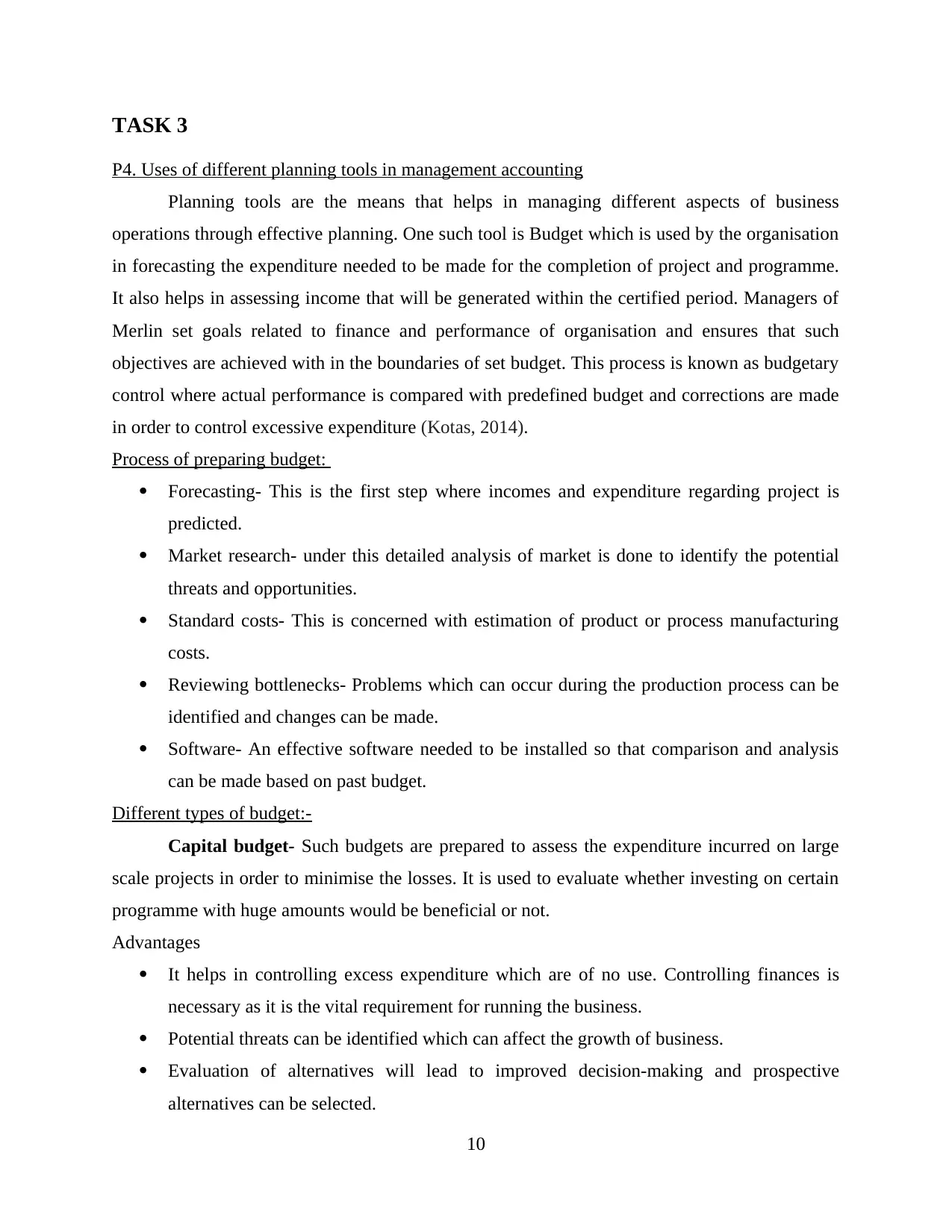
TASK 3
P4. Uses of different planning tools in management accounting
Planning tools are the means that helps in managing different aspects of business
operations through effective planning. One such tool is Budget which is used by the organisation
in forecasting the expenditure needed to be made for the completion of project and programme.
It also helps in assessing income that will be generated within the certified period. Managers of
Merlin set goals related to finance and performance of organisation and ensures that such
objectives are achieved with in the boundaries of set budget. This process is known as budgetary
control where actual performance is compared with predefined budget and corrections are made
in order to control excessive expenditure (Kotas, 2014).
Process of preparing budget:
Forecasting- This is the first step where incomes and expenditure regarding project is
predicted.
Market research- under this detailed analysis of market is done to identify the potential
threats and opportunities.
Standard costs- This is concerned with estimation of product or process manufacturing
costs.
Reviewing bottlenecks- Problems which can occur during the production process can be
identified and changes can be made.
Software- An effective software needed to be installed so that comparison and analysis
can be made based on past budget.
Different types of budget:-
Capital budget- Such budgets are prepared to assess the expenditure incurred on large
scale projects in order to minimise the losses. It is used to evaluate whether investing on certain
programme with huge amounts would be beneficial or not.
Advantages
It helps in controlling excess expenditure which are of no use. Controlling finances is
necessary as it is the vital requirement for running the business.
Potential threats can be identified which can affect the growth of business.
Evaluation of alternatives will lead to improved decision-making and prospective
alternatives can be selected.
10
P4. Uses of different planning tools in management accounting
Planning tools are the means that helps in managing different aspects of business
operations through effective planning. One such tool is Budget which is used by the organisation
in forecasting the expenditure needed to be made for the completion of project and programme.
It also helps in assessing income that will be generated within the certified period. Managers of
Merlin set goals related to finance and performance of organisation and ensures that such
objectives are achieved with in the boundaries of set budget. This process is known as budgetary
control where actual performance is compared with predefined budget and corrections are made
in order to control excessive expenditure (Kotas, 2014).
Process of preparing budget:
Forecasting- This is the first step where incomes and expenditure regarding project is
predicted.
Market research- under this detailed analysis of market is done to identify the potential
threats and opportunities.
Standard costs- This is concerned with estimation of product or process manufacturing
costs.
Reviewing bottlenecks- Problems which can occur during the production process can be
identified and changes can be made.
Software- An effective software needed to be installed so that comparison and analysis
can be made based on past budget.
Different types of budget:-
Capital budget- Such budgets are prepared to assess the expenditure incurred on large
scale projects in order to minimise the losses. It is used to evaluate whether investing on certain
programme with huge amounts would be beneficial or not.
Advantages
It helps in controlling excess expenditure which are of no use. Controlling finances is
necessary as it is the vital requirement for running the business.
Potential threats can be identified which can affect the growth of business.
Evaluation of alternatives will lead to improved decision-making and prospective
alternatives can be selected.
10
⊘ This is a preview!⊘
Do you want full access?
Subscribe today to unlock all pages.

Trusted by 1+ million students worldwide
1 out of 19
Related Documents
Your All-in-One AI-Powered Toolkit for Academic Success.
+13062052269
info@desklib.com
Available 24*7 on WhatsApp / Email
![[object Object]](/_next/static/media/star-bottom.7253800d.svg)
Unlock your academic potential
Copyright © 2020–2025 A2Z Services. All Rights Reserved. Developed and managed by ZUCOL.





